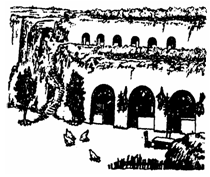He’s out there somewhere, an instant icon in the records of American conflict, the final big-game hunter. But a puzzle, too, his identity would be kept a secret for now, and maybe forever.
He is the unknown shooter. The nameless, faceless triggerman who put a bullet in the head of the world’s most notorious(臭名昭著的)terrorist, Bin Laden.
He’s likely between the ages of 26 and 33, says Marcinko, founder of the “SEALs Team 6” that many believe led the attack on Bin Laden in Abbottabad, Pakistan. He’ll be old enough to have had time to hurdle the extra training tests required to join the counter-terrorism unit, yet young enough to stand the body-punishing harshness of the job. The shooter’s a man, it’s safe to say, because there are no women in the SEALs. And there’s a good chance he’s white, though the SEALs have stepped up efforts to increase the number of minorities in their ranks, Marcinko and Smith say.
He was probably a high school or college athlete, Smith says, a physical specimen who combines strength, speed and wisdom. “They call themselves ‘tactical athletes,’” says Smith, who works with many future SEALs in his Heroes of Tomorrow training program in Severna Park. “It’s getting very scientific.”
Marcinko puts it in more conventional terms: “He’ll be ripped,” says the author of the best-selling autobiography “Rogue Warrior.”“He’s got a lot of upper-body strength. Long arms. Thin waist. Flat stomach.”
On this point, Greitens departs a bit. “You can’t make a lot of physical assumptions,” says the author of “The Heart and the Fist: The Education of a Humanitarian, the Making of a Navy SEAL.” There are SEALs who are 5 feet 4 and SEALs who are 6 feet 5, Greitens says. In his training group, he adds, there were college football boys who couldn’t hack it; those who survived were most often men in good shape, but they also had a willingness to show their concerns in favor of the mission.
The shooter’s probably not the crew-cut(平头), neatly shaven ideal we’ve come to expect from American fighting forces. “He’s bearded, rough-looking, like a street naughty boy,” Marcinko supposes. “You don’t want to stick out.” Marcinko calls it “modified grooming standards.”
His hands will be calloused(长老茧), Smith says, or just rough enough,” as Marcinko puts it. And “he’s got frag in him somewhere,” Marcinko says, using the battlefield shorthand for “fragments” of bullets or explosive devices. This will not have been the shooter’s first adventure. Marcinko estimates that he might have made a dozen or more deployments(部署), tours when he was likely to have dealt with quite a number of dangerous situations, getting ready any time for explosive devices or bullets.
小题1:Which of the following is most likely to be the title of the passage?
A.Who shot Bin Laden?
B.What do the SEALS do?
C.How can boys be SEALS?
D.What SEALS are like?小题2: From the passage we can know that the writer ___________.
A.knows clearly what the shooter is like
B.doubts whether Bin Laden is dead
C.is certain that the shooter is a man
D.is not sure of the shooter’s gender小题3:We can say for sure according to the passage that___________.
A.the shooter will eventually be revealed in the Press
B.the writer is a person who is curious about the shooter
C.the writer is a detective who tries to arrest the shooter
D.the shooter is a strong man with a pair of rough hands小题4:Which of the following are the names of writers mentioned in the passage?
①. Marcinko ②. Greitens ③. Smith ④. Abbottabad
A.①④
B.③④
C.②③
D.①②

